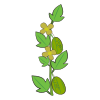Cucamelons, also known as Mexican sour gherkins or Melothria scabra, are intriguing little fruits that resemble miniature watermelons but are actually more closely related to cucumbers. These tiny delights are native to Central America and Mexico and have been a part of traditional diets there for centuries.
Cucamelons are about the size of grapes and have a crunchy texture similar to cucumbers, with a slightly tangy and citrusy flavour that some liken to a cucumber soaked in lime juice. Their unique appearance and refreshing taste make them popular in culinary uses, especially in salads, salsas, and as garnishes in cocktails.
Cultivation-wise, cucamelons are vining plants that are relatively easy to grow, similar to regular cucumbers. They are resilient, drought-resistant, and tend to be less prone to pests than many other garden vegetables. These qualities, along with their ornamental appeal, make them a favoured choice among gardeners looking for something both attractive and edible to add to their gardens.
Nutritionally, cucamelons are low in calories and provide a good source of vitamins and minerals, particularly vitamin C and potassium, making them a healthy addition to any diet. Their charming size and mild flavour profile also appeal to children, encouraging a fun way to enjoy more fruits and vegetables.
How To Grow
Growing cucamelons is an enjoyable gardening project, especially since these little fruits are both charming and low-maintenance. Here’s a step-by-step guide on how to grow cucamelons:
-
Seed Starting
Timing: Start cucamelon seeds indoors about 4-6 weeks before the last expected frost date in your area. They can also be direct-sown outdoors, but only after the threat of frost has passed.
Sowing: Plant seeds about 1/2 inch deep in small pots filled with well-draining seed starting mix. Keep the soil moist but not waterlogged.
-
Transplanting
Hardening Off: Before transplanting outdoors, gradually acclimate the seedlings to outdoor conditions by setting them outside for a few hours each day, gradually increasing the time over the course of a week.
Planting Out: Transplant the seedlings when they are sturdy and after all risk of frost has passed. Choose a sunny spot with support for climbing, such as a trellis or netting.
-
Site and Soil
Location: Cucamelons thrive in a sunny position receiving at least 6 hours of sunlight per day.
Soil: They prefer fertile, well-draining soil with a pH between 6.0 and 7.0. Amend the soil with compost or well-rotted manure before planting to improve fertility and drainage.
-
Watering
Regular Watering: Water regularly to keep the soil consistently moist. Cucamelons are somewhat drought tolerant, but they will produce better with adequate water.
-
Support
Trellising: Provide a trellis or other support structure at planting time. Cucamelon vines can grow up to 10 feet and will readily climb. This also helps to keep the fruits clean and makes harvesting easier.
-
Care and Maintenance
Mulching: Apply a layer of organic mulch around the base of the plants to help retain moisture, suppress weeds, and keep the roots cool.
Feeding: Feed with a balanced, water-soluble fertilizer every 4-6 weeks during the growing season.
-
Pest and Disease Management
Cucamelons are relatively resistant to pests and diseases, but keep an eye out for common cucumber issues like aphids and powdery mildew. Treat with organic pesticides if necessary.
How/When To Harvesting
Harvesting cucamelons is a straightforward process that adds an enjoyable task to your gardening routine, especially given their unique, mini-watermelon appearance. Here’s how you can successfully harvest cucamelons:
-
Know When They're Ready
Cucamelons should be harvested when they are about the size of grapes and have a firm texture. The skin should look like a tiny watermelon, marked by the distinctive green and dark green stripes.
The fruits typically mature approximately 60-70 days after planting, depending on growing conditions.
-
Regular Checking
Once cucamelons start to appear, check your plants every few days. These fruits can grow quickly and are best harvested before they get too large or overripe.
Regular harvesting encourages the plants to produce more fruit.
-
How to Pick
To harvest, gently hold the cucamelon and twist it off the vine, or use a pair of scissors or sharp clippers to snip it off. Be careful not to pull too hard as this could damage the vine and reduce future yield.
Handle the cucamelons gently to avoid bruising them.
-
Continuous Harvest
Cucamelons will continue to produce fruit throughout the growing season if they are picked regularly. Keep an eye on your plants and harvest every 2-3 days once they start producing.
-
Post-Harvest Care
After harvesting, cucamelons can be eaten fresh, added to salads, pickled, or used as a garnish in drinks. They don’t need to be peeled; just give them a good wash before eating.
If not used immediately, they can be stored in the refrigerator where they will keep for a few weeks. Ensure they are dry before storing to prevent mould.
-
End of Season
As the growing season ends, you might find smaller, underdeveloped cucamelons on the vines. These can still be harvested before the first frost and used as you would the fully matured fruits.
If you experience an unexpected early frost, cover the plants with a frost cloth to protect them and extend the harvesting period.


